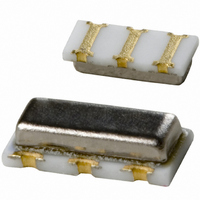CSTCR4M00G53Z-R0 Murata Electronics North America, CSTCR4M00G53Z-R0 Datasheet - Page 4

CSTCR4M00G53Z-R0
Manufacturer Part Number
CSTCR4M00G53Z-R0
Description
RESONATOR 4.00MHZ CERAMIC INDUST
Manufacturer
Murata Electronics North America
Series
CERALOCK®, CSTCRr
Type
Ceramicr
Specifications of CSTCR4M00G53Z-R0
Frequency
4MHz
Features
Built in Capacitor
Frequency Stability
±0.2%
Frequency Tolerance
±0.5%
Impedance
60 Ohm
Capacitance
15pF
Operating Temperature
-40°C ~ 125°C
Mounting Type
Surface Mount
Package / Case
3-SMD, Non-Standard
Size / Dimension
0.177" L x 0.079" W (4.50mm x 2.00mm)
Height
0.045" (1.15mm)
Lead Free Status / RoHS Status
Lead free / RoHS Compliant
Other names
490-1217-2
Available stocks
Company
Part Number
Manufacturer
Quantity
Price
Company:
Part Number:
CSTCR4M00G53Z-R0
Manufacturer:
MURATA
Quantity:
240 000
1
Note
• This PDF catalog is downloaded from the website of Murata Manufacturing co., ltd. Therefore, it’s specifications are subject to change or our products in it may be discontinued without advance notice. Please check with our
• This PDF catalog has only typical specifications because there is no space for detailed specifications. Therefore, please approve our product specifications or transact the approval sheet for product specifications before ordering.
sales representatives or product engineers before ordering.
Ceramic resonators use the mechanical resonance of
piezoelectric ceramics. (Generally, lead zirconium
titanate: PZT.)
The oscillation mode varies with resonant frequency.
The table on the right shows this relationship.
As a resonator device, quartz crystal is well-known. RC
oscillation circuits and LC oscillation circuits are also
used to produce electrical resonance. The following are
the characteristics of CERALOCK
The table briefly describes the characteristics of various
oscillator elements.
2
1. General Characteristics of CERALOCK
① High stability of oscillation frequency
② Small configuration and light weight
③ Low price, non-adjustment
1
Oscillation frequency stability is between that of
the quartz crystal and LC or RC oscillation circuits.
The temperature coefficient of quartz crystal is
10
for LC or RC oscillation circuits. Compared with
these, it is 10
resonators.
The ceramic resonator is half the size of popular
quartz crystals.
CERALOCK
cost and high stability.
Unlike RC or LC circuits, ceramic resonators use
mechanical resonance. This means it is not
basically affected by external circuits or by the
fluctuation of the supply voltage.
Highly stable oscillation circuits can therefore be
made without the need of adjustment.
–6
/°C maximum and approximately 10
Characteristics and Types of CERALOCK
®
–5
is mass produced, resulting in low
/°C at –20 to +80°C for ceramic
®
.
–3
to 10
–4
/°C
®
■
■
Resonator
Vibration Mode
1
Flexural
mode
2
Length
mode
3
Area
expansion
mode
4
Radius
vibration
5
Shear
thickness
mode
6
Thickness
expander
mode
7
Surface
acoustic
wave
Ceramic
Crystal
Quartz
Name
Vibration Mode and Frequency Range
Characteristics of Various Oscillator Elements
CR
LC
Frequency (Hz)
Symbol
Inexpen-
sive
Inexpen-
sive
Expen-
sive
Inexpen-
sive
Price
1k
Small
Small
10k 100k
Size
Big
Big
[Note] : ← — → show the direction of vibration
Not
required
Not
required
Required
Required
Adjust-
ment
1M
Oscillation
Frequency
±0.001% Excellent
Tolerance
±2.0%
±2.0%
±0.5%
10M 100M
Initial
Long-term
Excellent
Stability
Fair
Fair
1G
®
P17E.pdf
10.8.3






















